|
|
Elephant Fountain Obelisk (Also called: Catania Obelisk)
| Present Site: | Piazza del Duomo, Catania, Sicilia, Italy N 37°30'09.0"(37.502493) E 15°05'13.5"(15.087091) |
| Pharaoh: | Unknown |
| Measurement: | 3.66 meters high for obelisk itself |
| Stone: | Red granite ? |
About The Site:
Catania is the second largest city in Sicily (Sicilia), after Palermo, has a population of 290,000. Eight towns/cities of south-eastern Sicily including Catania were listed as UNESCO World Heritage of "Late Baroque Towns of the Val di Noto (South-Eastern Sicily)" in 2002.
Catania is a city that was created as a colonial city of Greece in the 8th century BC, but it also affected many times by eruptions and earthquakes of Mount Etna volcano nearby. In recently, Catania was largely damaged by the eruption and earthquakes in late 17th century, was then rebuilt with the beautiful streets of the Baroque architecture as seen now in the 18th century. Also the old buildings remain throughout, but it is seen the buildings using the black volcano rocks using the lava of Mount Etna.
Speaking of Sicily, we bring up the image of Mafia, and was know as a poor security city in 1960s. But after the listing of World Heritage sites, the city is said that to have become quite beautiful.
Piazza del Duomo where the obelisk stands is the center of Catania, and is the starting point of transportation for tourists.
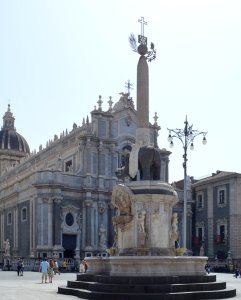 Obelisk in Piazza del Duomo
Obelisk in Piazza del DuomoThe building in back is Duomo of Catania (Cathedral of Sant'Agata). The black elephant is facing the Duomo. |
How To Get There:
Although we can go by rail, but it takes quite a long time, it's recommended using the airlines which available a number of flights if you go from Rome. From the airport of Catania, the taxi or bus are available to the Piazza del Duomo.
In the case of bus, you take a city bus (#457) named "Alibus", the fare was only € 1 (as of August 2014). You should tell the bus driver in advance, please let me get off at the Piazza del Duomo.
In the case of taxi, the fare is about € 30. When you return to the airport, the taxi is convenient from the city, as the bus terminal for the airport is a little hard to find.
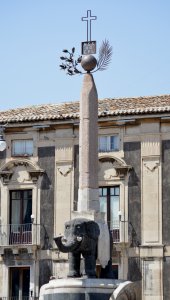 Statue of black elephant facing east.
Statue of black elephant facing east.
|
About The Obelisk:
The characteristics of this obelisk is to be trimmed off of the four corners, the cross-section has the octagon. There is no inscription of hieroglyphs, but the Egyptian-like figures are engraved. A certain Italian website often says, it was mabe in Egypt, and the Godess Isis is engraved. But I don't think it's correct because the octagonal obelisk is hard imagine, and the inscription pattern must be more conforming to the faithful in Egyptian ancient style. Therefore, many specialized books on obelisk estimate that it was made in Sicily in the Roman Empire era. The height of the obelisk is small as 3.66 m.
The material is looked similar to the red granite of Aswan production, the stone is there is a possibility that was transported from Egypt, like Caesarea Obelisk of Israel.
This obelisk stands on the Fountain, and the black elephant statue.
This statue of elephant is made of volcanic stone (lava). There is no reliable record on when and by whom was made. It is supposed have sculpted during the Roman Era for placing at the Circo Massimo, or it was the memorial of a religion which today is completely lost the trail.
However in 1239, elephant which is locally called "Liotru" (Sicilian language) was an emblem of Catania. The elephant is placed in the coat of arms, the crest of the university and now is the mascot of local football team of Calcio Catania. City's Town Hall is popularly called "Palazzo degli Elefanti" (Elephants Palace) because the windows outside are decorated with bas-reliefs of small elephants.
The Elephant Fountain, which is a base of elephant, was made by an architect Giovanni Battista Vaccarini, and he assembled the obelisk and the elephant when the Piazza was redesigned in 18th Century, on the model of Bernini's Minerva Elephant in Rome. The whole was completed in 1736. The two sculptures both North and South sides stand reproduce the two rivers in Catania, the Simeto and the Amen. The existing pool was added in 1757. Then the 2nd pool which is larger one surrounding by the jet water and the belt garden and the iron railing were added in 1905. But, the 2nd pool, belt garden and the railing were removed in 1998, and replaced with the 3 stone steps. Hence we can sit and rest there.
On the top part of the obelisk, it is mounted a globe surrounded by a wreath of palm leaves and olive, more metal on a tablet on which is the inscription dedicated to St. Agatha MSSHDEPL ("A healthy mind and sincere for the honor of God and the liberation of his country"), and finally a cross.
Notes For Pictures:
In some web sites for the tourist information on Sicily, it was written as "should not come to Catania in the summer." In fact, I have tried to aboard on the open roof bus that visits Taormina, but heat was abnormal, and the sunshine was very strong. Since the bust doesn't start until the passengers gather enough, the some tourists who have been waiting from earlier can not withstand the heat and got anger, before departure.
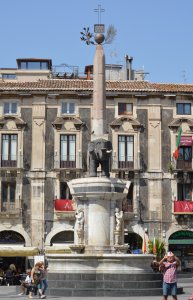 East Side |
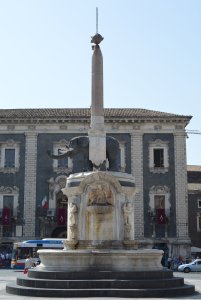 North Side |
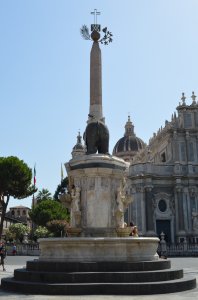 West Side |
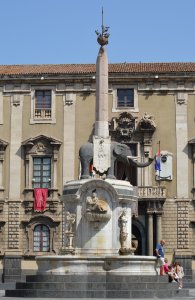 South Side |
|||
August 14, 2014 by Hiroyuki Nagase (For high definition image, please click the picture) | ||||||
Copyright Hiroyuki Nagase nagase@obelisks.org and Shoji Okamoto okamoto@obelisks.org